How to produce US dollars
None of us did not pass the fever associated with the recent collapse of the ruble (and previous, too). Some rushed to buy dollars and other urgently sell them, others zatarilis in hypermarkets killogramm televisions and other household appliances, which undoubtedly will always be in the price and it can then be exchanged for a pleasant buckwheat).
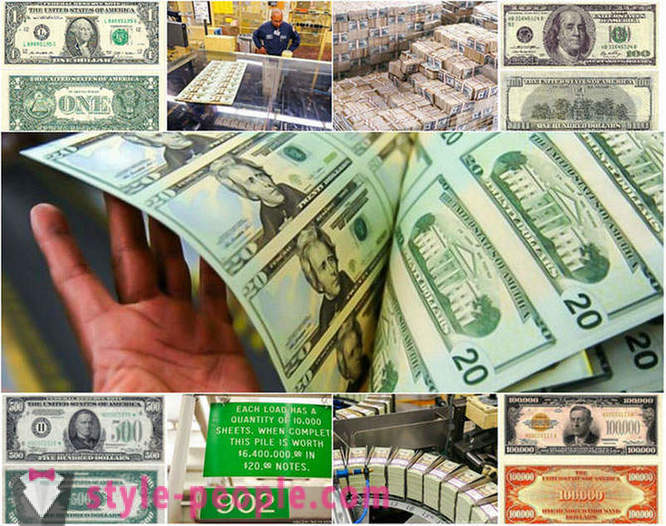
But today we will not talk about the storm on the currency markets, and on how to do this same currency, or rather the dollar - the most popular and widespread currency in the world. At the same time we spend a little history and tell a little about banknotes of various denominations.
Dollars born in this institution, it is the US Bureau of Engraving and Printing, which is part of the US Treasury Department. The Bureau was founded in 1862 in Washington and specializes in the issue of securities, and in particular bank notes. The Bureau operates more than 2 thousand people. Coins are minted at the Mint, the main office is also located in the US capital.
Incidentally, according to Bureau of guided tours, which can sign anyone, so Wellcome!

It all starts with an engraving on the steel plates that make the master who studied the case for at least 10 years. This time-consuming work, akin to jewelry, which requires very precise, detailed work. The quality of the engraving depends on the level of protection against counterfeiting.
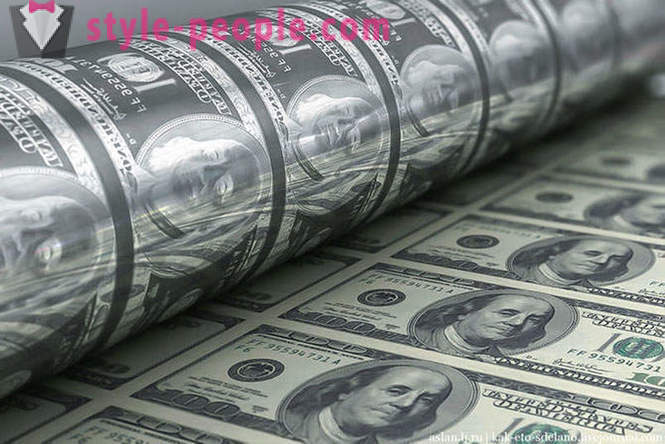
After engraving is ready, you need to make a special paper. Dollars do not print on plain paper, manufactured from wood, so they are not turned yellow with time. They are made from a mass consisting of 25% of flax fibers and 75% - cotton. Paper reinforced with synthetic fibers (up to the First World War this function was performed by silk thread). US Bureau of Engraving and Printing makes this paper "Crane and Company", which is located in Massachusetts.
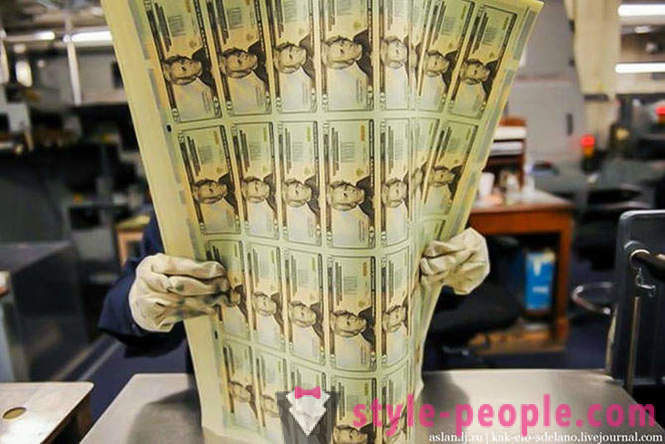
The process of preparing paper consists of 8 steps. First, the weight of the linen and cotton boiled, then it was clarified scrub and then pressed and it enters the machine, where it is softened at a specific temperature and converted into mush.
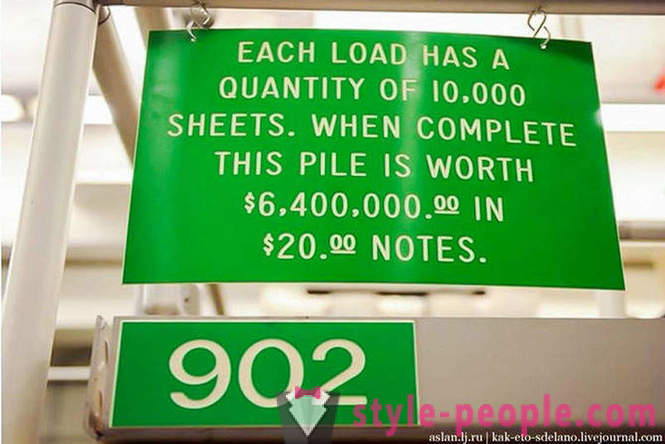
In the banknote, which is produced has an inner layer that is virtually impossible to forge this paper. Watermark your dollars are obtained when a specific order of this layer are drawn fiber. Also on the stage of preparation of paper in it sewed protective strip, which appeared in the last banknote samples.
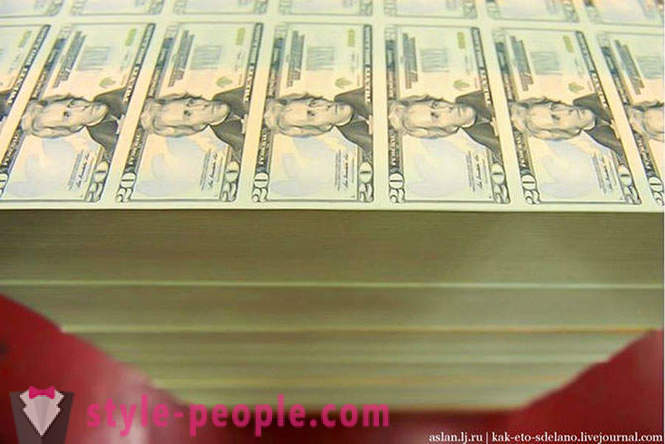
After these steps, the paper is dried under special pressure and then rolled into large rolls of 2.5 meters wide and weighing more than 4 tons. On paper already has a watermark and security thread, and each roll is used to make a specific denomination banknotes. Each of the roll can be printed 3.5 billion dollar bills.
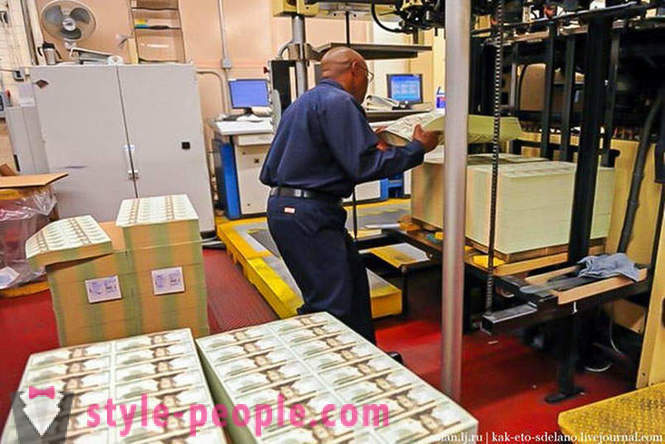
Then the rolls with water marks and security threads arrive at the same US Bureau of Engraving and Printing. There is a very serious security and video surveillance system is the largest among similar organizations to control all stages of production and dollars on the theft case. When workers enter the building, the complex scanning system monitors their every move. The critical areas are built alarm and tracking detectors. Office building is divided into special zones, where only workers with a certain access can get.

The process of the production of banknotes consists of six stages, each of which is directed to protection against counterfeits. One of them - the engraving, which we already know something. After working engraver it is taken for unique simultaneous machines that print simultaneously on both sides. This machine complements the notes in different colors and subtle figures. Speaking of ink. Initially, at the beginning of its introduction dollars printed dark color, but during the war between North and South required to print new banknotes for the astronomical sum in those days - $ 60 million. The order was sent to the New York printing company "American Bank Note Co." Given that Congress authorized the release of only denominations of 5, 10 and 20 dollars, you can imagine what an enormous amount of notes had to make. Printers approached the matter from a purely practical side: they have checked primarily paints stock inventory and found that most of the green. Tradition has strengthened with time and dollars until recently printed just green paint, which is also quite cheap.
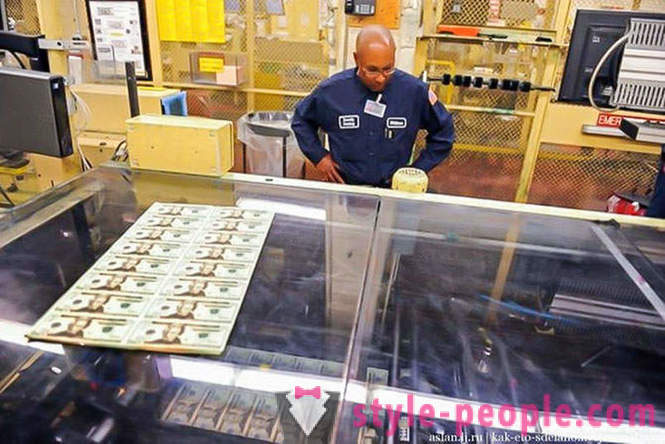
The paint is also produced specifically for the US Bureau of Engraving and Printing, and has a high level of wear resistance.
After printing paper paint dries within 72 hours. Then comes the turn of gravure printing. Special press presses the paper into the ink-filled recesses, creating a texture, which is difficult to copy. None color photocopier can not achieve this effect. Intaglio printing is applied to each side of the note, and then the paper dries again in three days.
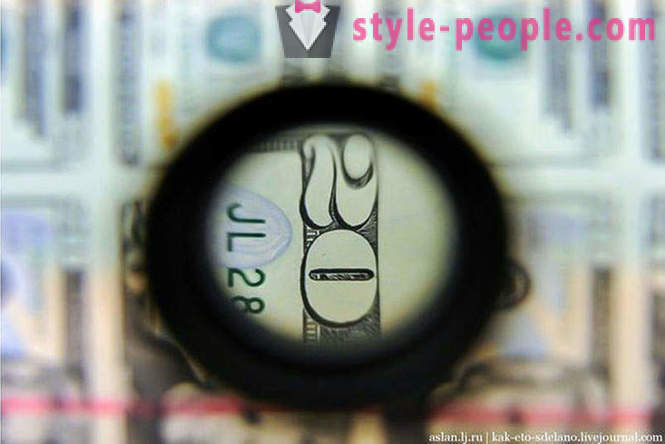
Every day through these media are 1.3 tons of ink of three colors, as well as 10 thousand. Sheets of newspaper format. 24 working in the press bureau produce about 35 million banknotes of various denominations for a total of about 650 million. Dollars daily. 95% of the banknotes are printed annually, are used to replace worn-out money.
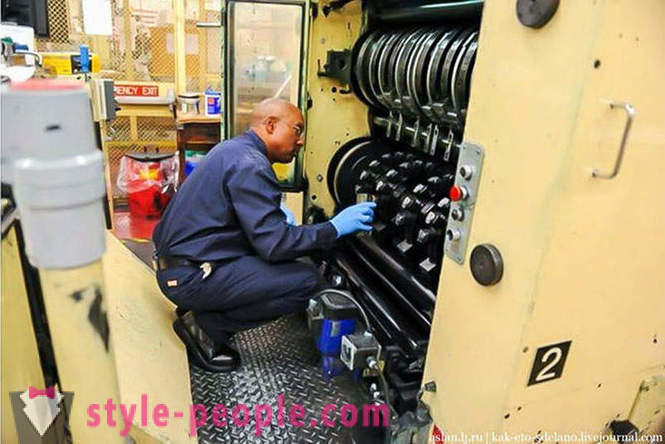
When the ink is dry and the sheets with drawings of banknotes ready, it goes to the next step - scanning to detect defects. Weed out defective dollars is as important as, and to identify a fake. to check each sheet need only a second, and then the sheet is assigned a number. The computer can simultaneously check up to 37 sheets, comparing the sample with millions of tiny squares. If the square is not the same way, its image is displayed on the monitor.
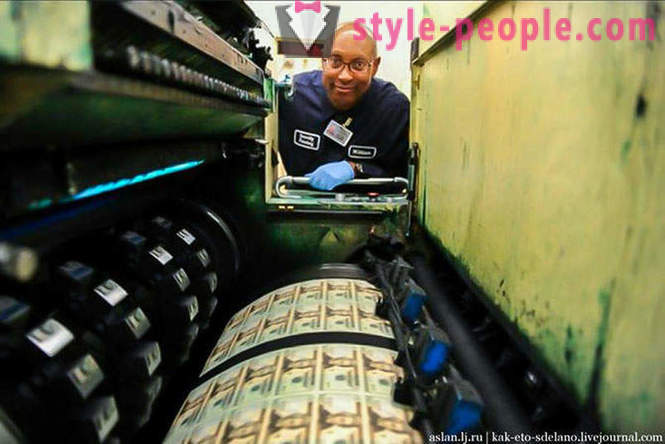
Defective banknotes are destroyed, but sometimes it happens that they fall into the hands of lovers of curiosities, where the marriage price increases in the hundreds or even thousands of times. After checking the sheets are assigned serial numbers and designations of the Federal Reserve. It's like a home address of money. Serial number, lot number and face value - are three factors distinguishing each sheet of paper from the rest. They are not repeated, because for each banknote can be determined the day when it was printed, and the place where it was issued.
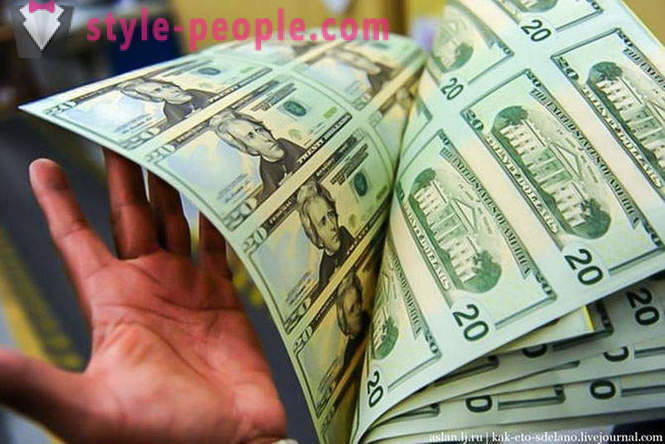
The right monetary emission (issue) have 12 banks - members of the Federal Reserve System. US territory was divided into 12 regions (districts), each with its own Federal Reserve Bank, which are digital and lettering, in alphabetical order:
Number territory Letter Center Location
A Boston 1
2 B NY
3C Philadelphia
4 D Cleveland
5 E Richmond
6 F Atlanta
7 G Chicago
8 H St. Louis
9 I Minneapolis
10 J Kansas City
11 K Dallas
12 L San Francisco
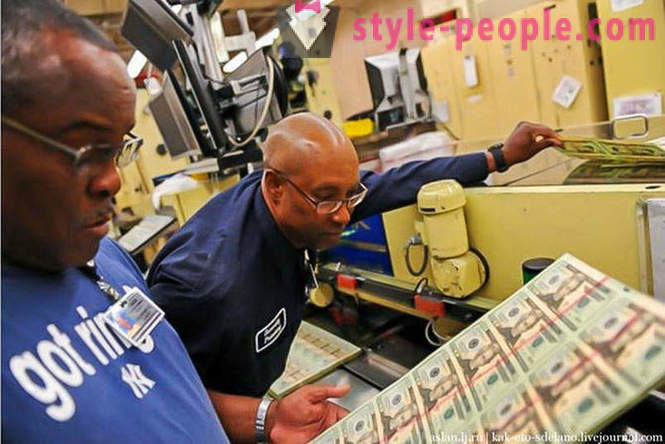
In the workshop, which lists the money for the final stage of the sheets finally cut. Then find and packaged.
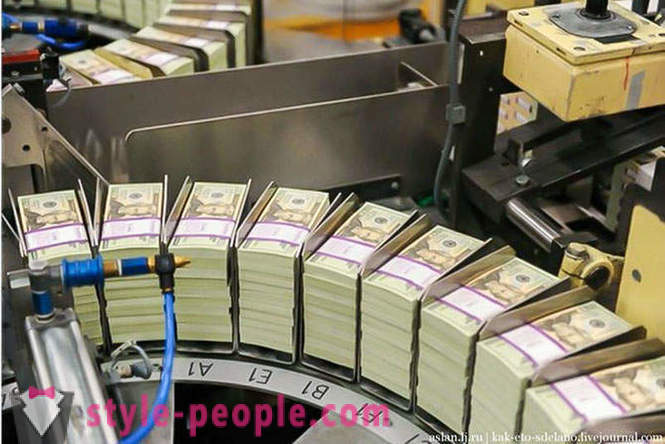
Now, they are ready to be sent to the Federal Reserve Bank, where rastekutsya wide river in different US banks, Europe and other countries, which are so necessary dollars.
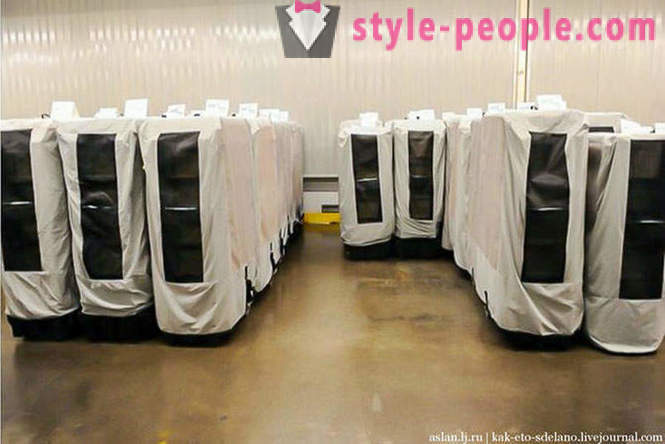
And now, some interesting facts about the US currency
Over the past 2013 the US Bureau of Engraving and Printing has produced 6.6 billion banknotes. The cost of manufacturing each banknote denomination regardless of only 10 cents. For comparison: sebistoimost coins of 1 cent - 7 cents.
All of the modern dollar bills are not dependent on the nominal value of the same size is 6.14 to 2.61 inches (155.956 to 66,294 mm).
In order for the bill has come into disrepair and was torn, it is required to bend 4000 times. According to the US Federal Reserve, the life of one-dollar banknotes is approximately 22 months. 5 $ "live" 24 months, $ 10 - 18, $ 20 - 25, $ 50 - $ 55 banknote 100 is a "long-lived" and circulates 60 months.
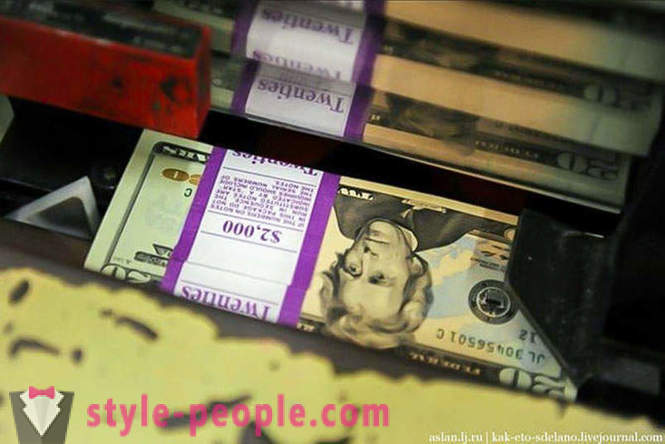
According to the US Department of Treasury (Eng. Department of Treasury), now about 99% of its dollar-denominated notes and coins are in free float. During the period from 1995 to 2005, the dollar amount outstanding, increased by 89% and reached 758.8 bln. $
As of September 30, 2006, there were notes and coins in the world for a total of 971 billion 922 million 146 thousand. $ 480, of which 790 billion 556 million 011 thousand. 806 $ were in free float (ie, for every person on the planet It accounted for $ 150). The most common banknotes in denominations of $ 100, $ 20 and $ 10.
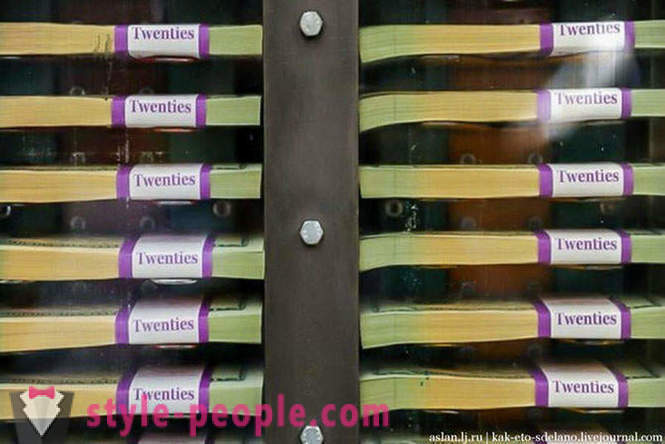
The US dollar also has the status of a national currency in some other countries, and is often more (parallel) currency in the countries where the national currency is not the only legal tender, including in cases where its own currency is not actually used in a cash and / or non-cash circulation.
Countries in which the dollar has the status of national currency:
Bermudas
Bonaire
British Virgin Islands
East Timor
Zimbabwe
Marshall Islands
Palau
Panama
Puerto-Rico
Saba
Salvador
St. Eustatius
Turks and Caicos
Federated States of Micronesia
Ecuador
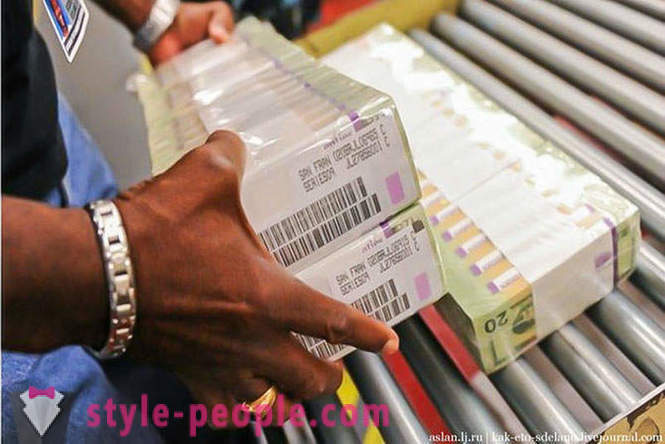
If you are not yet tired of these facts, it is still a bit of the story of the Federal Reserve Notes)
US dollar - the lowest face value ticket to the US Federal Reserve. On the front side of the banknote depicts a portrait of the first president, George Washington, painted by Gilbert Stuart. On the back - the two sides of the US Large Print.
Average Time Spent in everyday bills is about 70 months (about six years). In 2009, it produced more than 2, 5 billion dollar bills.
Modern reverse image design 1-dollar bill was approved even by Franklin Roosevelt in 1935. In this same view, with minor modifications (altered side printing), it still exists.
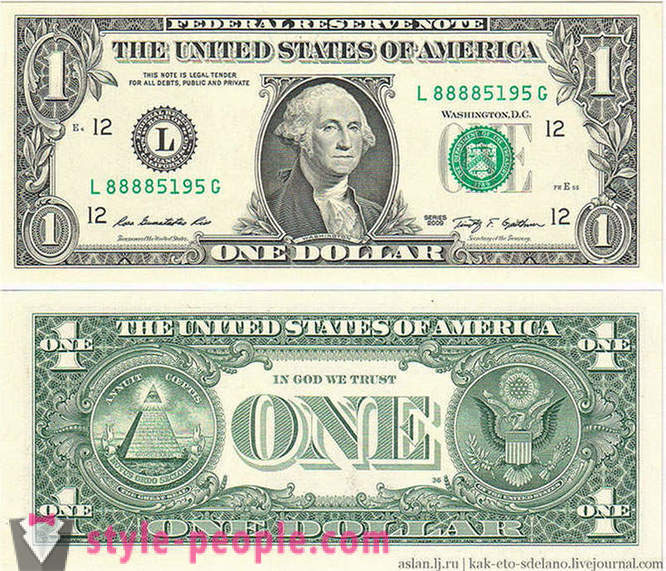
Two of the US dollar - the second par of the Federal Reserve ticket. On the obverse, Thomas Jefferson, on the back - a reproduction of the painting by John Trumbull, "Declaration of Independence".
denomination was discontinued in 1966, but 10 years later to celebrate the Bicentennial restored. Nowadays, new instances are hardly (about 1% of all issued bank notes), respectively, it is rarely seen in use. This gave rise to the myth that two-dollar bills taken out of circulation, which gives people the problems that they want to pay.
Rarity can be explained by the fact that the release of 1976 was unusually perceived by the public (and even become collectibles) was not claimed in the money transactions. By August 1996, when released a new series of these bills have almost disappeared. In 2014 fiscal year, the Bureau of Engraving and Printing plans to produce about 45 million two-dollar bills.
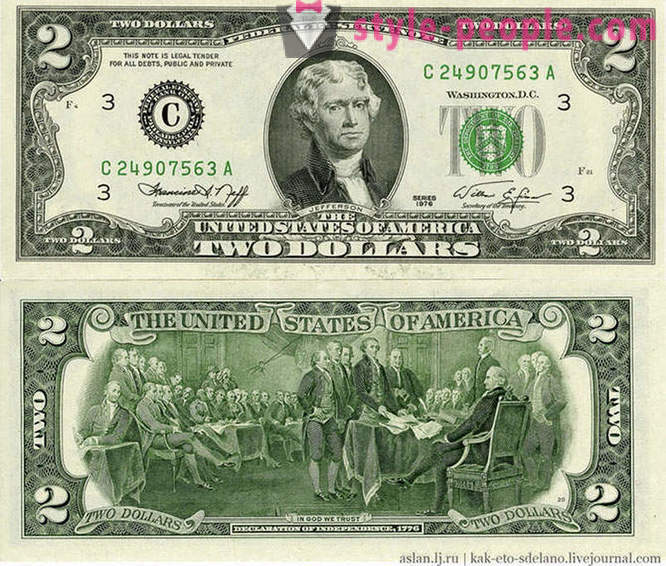
USD Five - the name of US banknotes. Currently, the obverse of the banknote there is a portrait of the 16th US President Abraham Lincoln, and on the reverse side - the Lincoln Memorial.
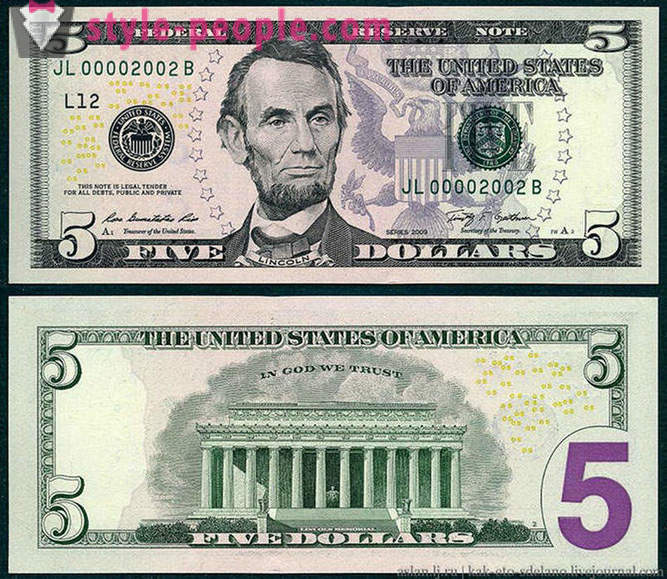
On the front of the bill at $ 10 a portrait of the first US Treasury Secretary - Alexander Hamilton, who was not a president of America, along with Benjamin Franklin. On the back of the building of the US Treasury. Currently, tickets are walking series 1996-2009, the wear resistance of about 18 months.
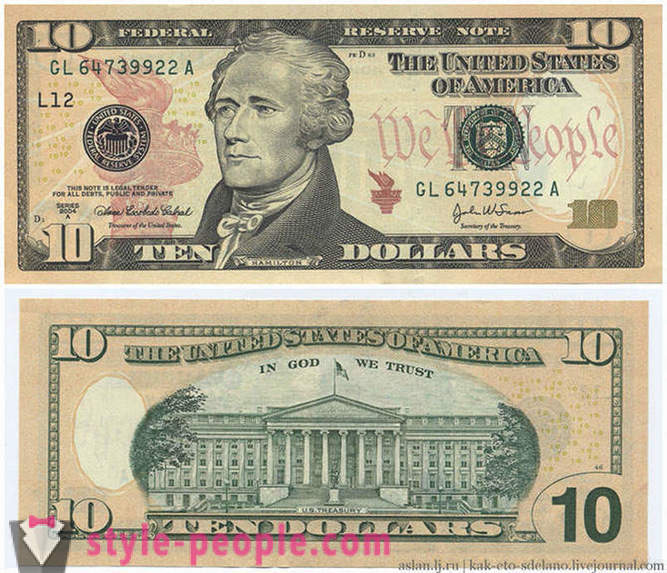
Twenty dollars. The obverse of the banknote depicts the 7th US president Andrew Jackson, on the reverse - the facade of the White House from the 16th Avenue. Currently, tickets are walking series 1996-2009 years.
Average life of banknotes is 25 months. 11% of US banknotes, printed in 2009, consisted of 20-dollar bills.
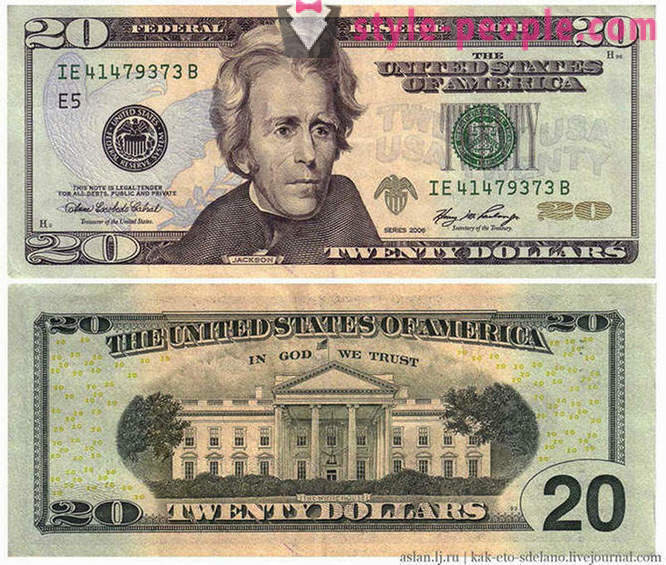
Fifty dollars. The obverse of the banknote depicts the 18th US President Ulysses S. Grant, on the reverse - US Capitol, where the middle of XIX century sits the US Congress. According to the Bureau, the life of the bill is 55 months. Approximately 6% of all printed banknotes in 2009 amounted to $ 50.
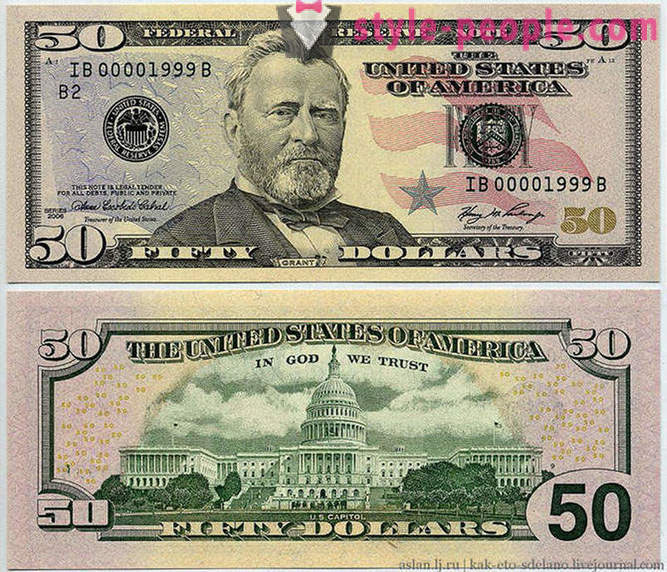
One hundred dollars - the largest denomination of the US Federal Reserve ticket in 1969 (although previously released more large bills in denominations of 500, 1000, 5000 and US $ 10 000 are valid). Currently in circulation tickets Series 1996-2009. On the obverse of Benjamin Franklin on the back - Independence Hall, where the Declaration of Independence was signed and the US Constitution.
The first hundred-dollar tickets were issued by the federal government in 1862. Franklin image first appeared in the series in 1914, and Independence Hall - in the series in 1928. In fiscal 2009, the Bureau of Engraving and Printing issued 1,785,600,000 hundred-dollar bills. According to the Office, the life of the bill - 89 months.
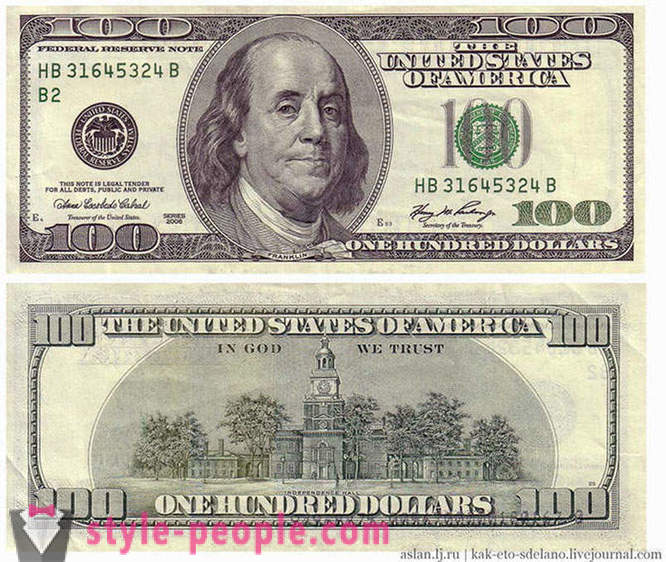
the 25 th US President William McKinley (born William McKinley.) - the bill of $ 500 in 1934.
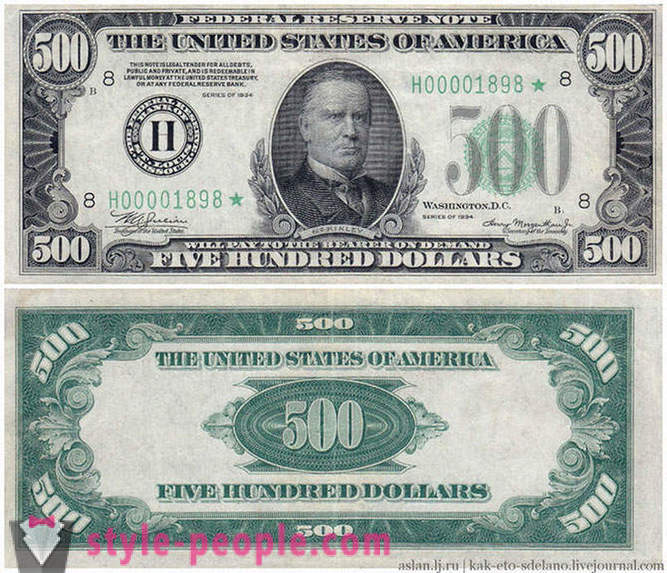
22th and 24th US President Grover Cleveland (Eng Grover Cleveland.) - the bill of $ 1,000 in 1934.
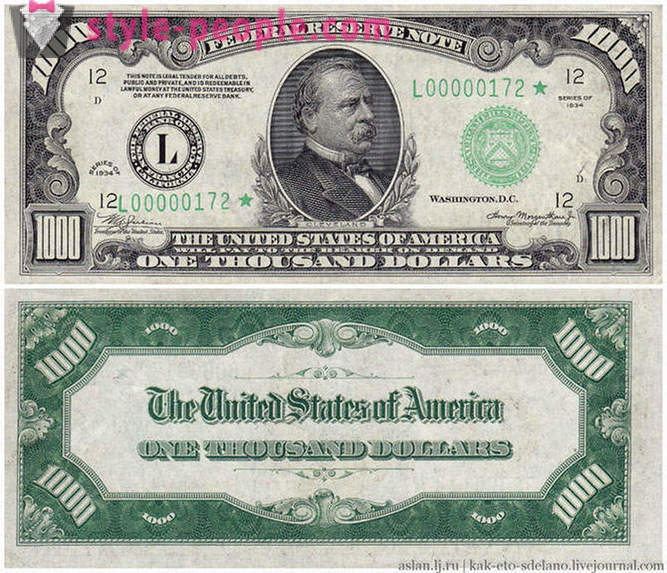
4-th president James Madison (born James Madison.) - the bill of $ 5,000.
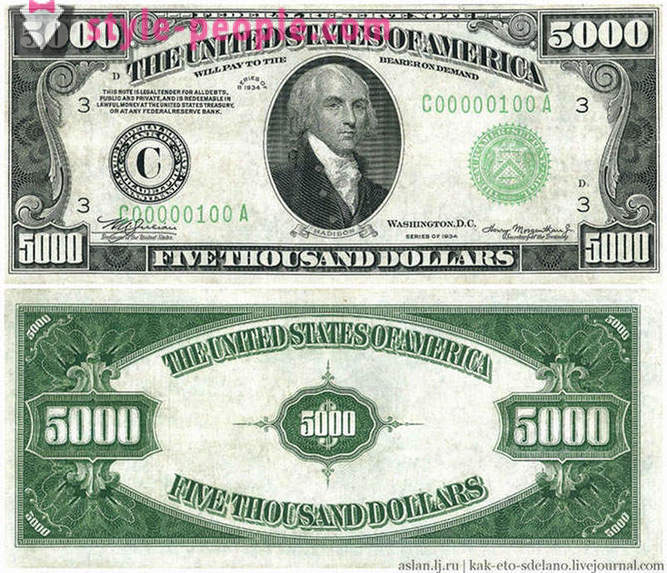
The head of the Ministry of Finance during the reign of President Lincoln, and later head of the Supreme Court of the United States Salmon Chase - the bill to $ 10 000 sample 1934. Last note issue was in 1944. Salmon Chase ordered the first place on the American money inscription "In God we trust" (English In God We Trust.) - it began to mint coins of denomination of 2 cents in 1864. On paper dollars she appeared in 1957, and since 1963 is used constantly. It is curious that the first banknote 1 dollar, released in 1863, contained not the image of George Washington, and a portrait of Salmon Chase (the bill 10 000 dollars is no longer available, but more than 100 pcs. Are still in circulation and are legal tender) .
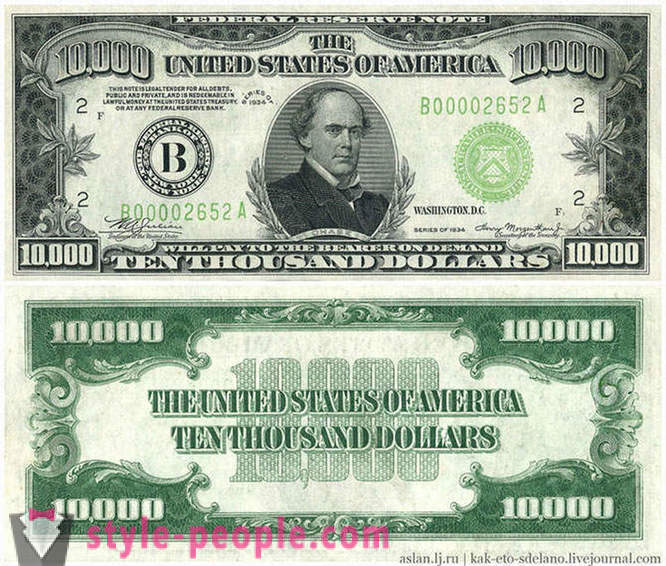
28th President Woodrow Wilson (born Woodrow Wilson.) - the bill to $ 100 000 issued in 1934 (the bill is designed for internal calculations of the US Federal Reserve, has never been in free float).
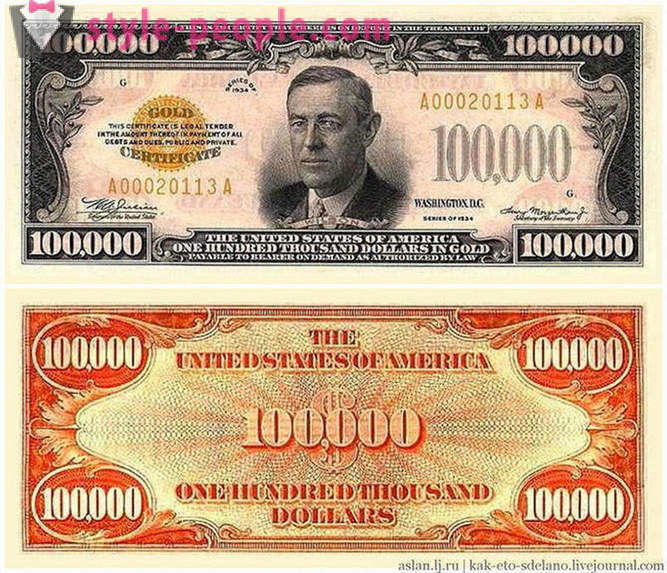
And for those who want to see first how to make money, you can see a video of this very office.













































